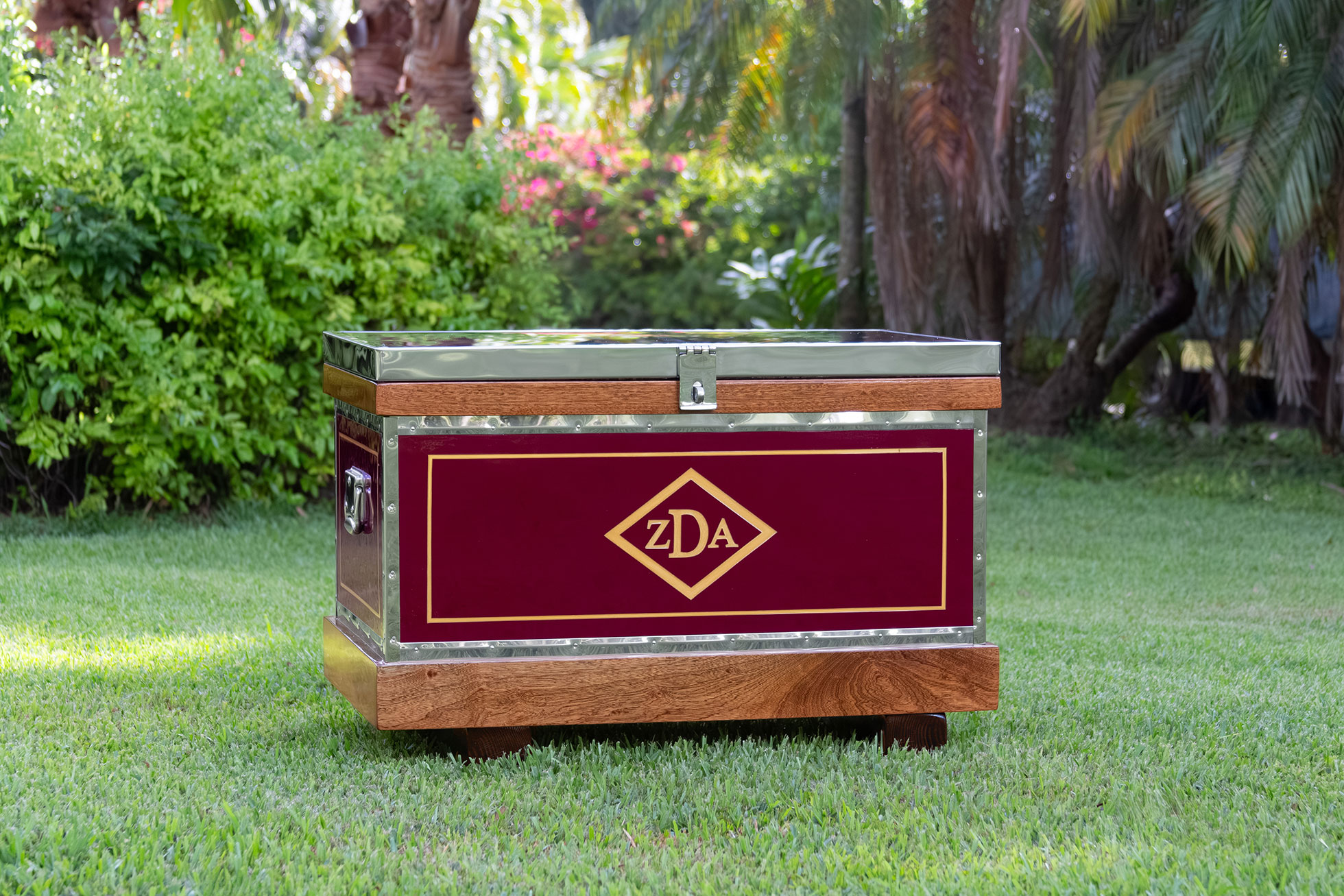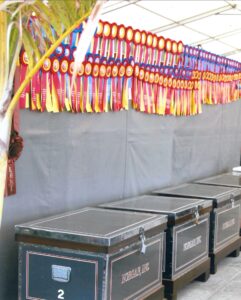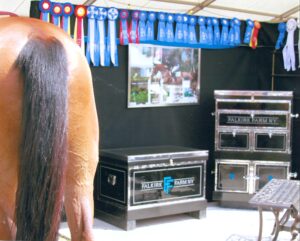Consider how you store things, move things and use things. What might help at the horse show? And what might help at the barn back home?
Consider how you store things, move things and use things. What might help at the horse show? And what might help at the barn back home?
Colors have always been associated with sport horses, military regiments, racing stables, and hunt clubs. Colors make your horse equipment identifiable, uniform and organized. Having colors promotes a sense of belonging to a group, a stable where everyone works together.
We make each item one at a time and the colors individually. They can be matched to paint chips from your hardware store, cooler or tack room drapes, farm sign, a picture in a magazine, a sweater you like or anything you choose to send us. Or you can simply tell us on the telephone which colors you want, and if either of us is uncertain as to the exact shade, we can send samples to you.


Hand-carved into the vinyl is artwork of your choice. Commonly used are names, monograms, initials or logos in your colors and to your specifications. We would be happy to work with you over the phone or via email.
Even though your first impression might be that these pieces should only be for the house, they can also be comfortably used in the barn or at the horse shows, as they have several coats of a protective marine spar varnish on them.
Due to our location in Fort Lauderdale, Florida, we have available to us an unusually wide selection of exotic hardwoods. These woods come to Port Everglades for use in the yacht building trade. For example, we have made trunks in: Mahogany, Cherry, Maple, Cypress, and Rosewood.

By Frito, for McGuinn Farms
“Elegance?”
This might not be the first word that pops into minds of those with long years of experience under the horse show tents. They might well conjure images of dust, heat, cold, and hard rains. And yet, for all of this, life under the canvas retains a connection to an older type of elegance. It has the flavor of the exotic adventure of military campaign, where the going was full of physical hardship but the objective remained compelling enough to keep everything moving onward.
As it happens, elegance has always accompanied the sport-horse. All of our senses are engaged: the sight of a horse under tack, the shine of the bits, the sound of breakfast, the smell of liniment, the feel of the reins. These are the enduring things and in few places are they honored more than with the hunters and the jumpers.
Consider the decoration of the horse show tents. As will a regiment claiming its territory, planting its flag, and displaying its colors, the show stable rolls into town and sets about its conquests. The tack room drapes, trunks, furnishings, and the landscaping are not ornamentation. They complement the horse and reflect the price of the show stable. They also establish a sense of order in the camp amid difficult conditions.

Horse show campaigning has taken many forms over the years. At one-day shows, the stable might consist of a station wagon pulling a two-horse trailer. The tack room is in the peak of the trailer and the horses wait for their classes tied to the side, eating from a hay net. If it is a good day, ribbons hang from a piece of twine strung the length of the trailer.
At two or three-day weekend shows, things have to be more elaborate. Here the organization and decoration of the temporary stabling is important to distinguish one barn from another and create a working environment that is as close to being at home as possible.
The great old shows at Devon or Bloomfield Hills of Upperville or the Milwaukee Hunt Club were a home to be visited each year. Many are gone now, the old wooden buildings and the ring fences removed as the land was given over to some other use. But the campaigns continue.
For many years much of our business was directed toward the making of trunks, wall boxes, and bridle and saddle racks. These, along with the tack room drapes, remain the stables of tent decoration for the weekend shows.
From an operational standpoint, there are two important characteristics to this type of showing. First, in many cases, the van or trailer can be close enough to the stalls to serve as storage space. And, second, even if a stable is going to these shows every weekend, the farm at home remains the base during the week.
However, neither is the case for the barns that are in Florida for most of the winter. For a stable at Palm Beach for four to six months, the distinction between “home” and “on the road” loses much of its meaning. It then becomes necessary to organize and decorate the tent (or permanent structure) in a very different manner.
They come and they go, all day long. It is tempting to associate daily work at the horse show with the activity of the in-gate schooling area. But getting horses and riders to that point places great demands on the operation under the tent. So what are the fundamentals of good tent design?
It has been our view that as a design proposition, equipment to be used around horses must pass one critical test: Will it work? Is it strong enough? Will it hold together being thrown off vans, airplanes, or out of the back of moving pick-up trucks? Form must follow function.
But form is also important. Not as mere decoration but as a legitimate reflection of the practices and customs that go on year after year. Because it is a horse show, polish and showmanship are rewarded. Much of our time is devoted to colors, designs, and monograms that appear on the boxes we make. The uniformity of the barn colors makes every one part of the team and is a hallmark of elegant tent design.
As with all great campaigns, it begins with pencil and paper. One customer told us that he designed his barn in about ten minutes on a plane. He knew exactly what he wanted. Sometimes it takes a bit longer. Ultimately, the elegance of the tent design may hinge on the quality of the floor plan sketched on the back of an envelope. After all, it is the last chance to think and plan before the troops start moving.
As a practical matter, much depends on the tent location and exposure. The southern and western sides of the tent are going to get a good deal of sun. They can be really hot. This may mean thinking about bringing awnings and fans. It may also determine where you put your tack rooms and grooming stalls.
The main thing about the floor plan is that it addresses the day-to-day footfalls of your stable. For example, there is merit in having a central hub, where tack rooms and grooming stalls are located, rather than having them at the periphery of the stabling. This saves steps and allows trainers and barn managers to see what is going on. Having a series of wipe off boards in the central area conveys the information necessary to keep all the moving pieces moving in the proper direction.
The shipping of the horse and equipment is another consideration. Ideally, things are packed ready to use. Many stables have cards in the lids of their tack trunks listing the contents. This way, detailed information can be conveyed to anyone working in the barn. Also, if things are packed in clusters, for the feed room, rack room, grooming stall, etc., it speeds up the turnaround time. It is always a good idea to pack the van in a way that medications are easily accessible in case of emergency.

Once at the show, an inspection should be made of the infrastructure under the tent. Check all the stall partitions for nails, splintered boards, or any sharp objects. You just never know. You might also take note of the topography. If you are a low lander, you might find yourself in the irrigation business if the rains are heavy. A system of trenches may be needed. Quite a while ago, Ingleside Farm told us that during the flooding at Chagrin one of the trunks we made for them was found floating down a river. Hopeful things will not get that bad, but it would not hurt to pack a couple of shovels.
No matter how organized one may be, the process of getting the stuff out of the van and into the tent has not evolved much since the building of the pyramids, except at least the old Egyptians has barges and other contrivances to lighten the load, we began making vertical trunks on wide, all-terrain wheels, in part, to make this business slightly less difficult. In general then, the more things that can be put on wheels or put in containers and cases with good handles, the better.
Once in place, everything will be easier to keep clean if it is up off the ground. We use stained and varnished 4x4s under the trunks: But it is also desirable to have a way to keep the feed and supplements high and safe. A few years ago we saw a friend sitting uncomfortably on the ground of her feed stall, mixing supplements. A system of boxes with drawers, doors, and shelves would keep things organized. Moreover, it is important to keep medicines in a container that is not only clean but can be locked. In the past, we have made vertical boxes with a refrigerator inside, which is nice for cold drinks but also to keep medicines at their proper temperature.
One of the other areas that merits some thought is the cleaning stall. Much is asked of this space. It requires a system of boxes for brushes, combs, and all the things necessary for grooming. It is good to have a box where clean and organized drawers pull out smoothly, containing small and crucial items such as caulks. Of course, many great horses have been brought to the ring over the years with little more than a milk crate tied to the wall. But with so many horses and riders to prepare on a given day, there is a real premium on having specific places for everything.
This is particularly evident during those parts of the day when the operating tempo picks up. This can be frenetic time, as expensive horses are prepared for important classes. The stakes become high. The trainers, owners, and riders are thinking about what will happen in the ring, the outcome of so much effort. This is not a good time to be hunting for some piece of equipment.
A deliberately different mood and tempo should prevail in the display area of the tent. This is the social space and primary means of advertisement for the stable. Framed by tack room drapes and often elaborate landscaping with bright flowers in planters, this is the place where, at the end of the day, everyone can actually sit down for a few minutes and talk.
The details do matter. They matter in the ring and back in the barns. The sand is raked, the blankets are hung straight, the hose is coiled: The daily protocols are observed. The tents are decorated as they are because the show is such hard work and the physical conditions can be so tough. That is the elegance (and the fun) of the thing.
14600 Mustang Trail
Fort Lauderdale, FL33330